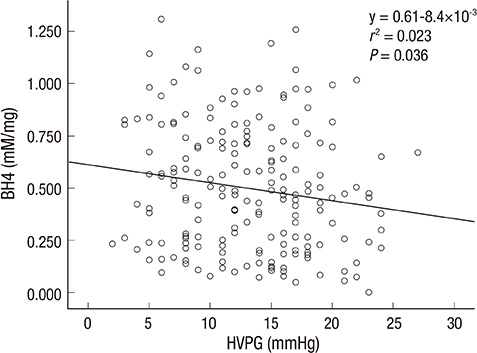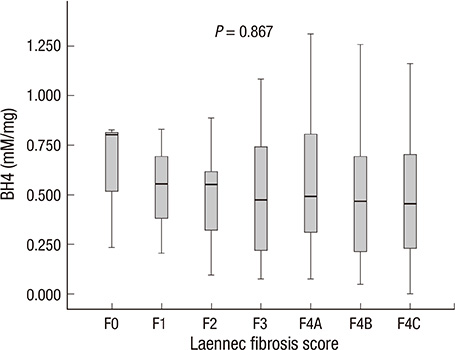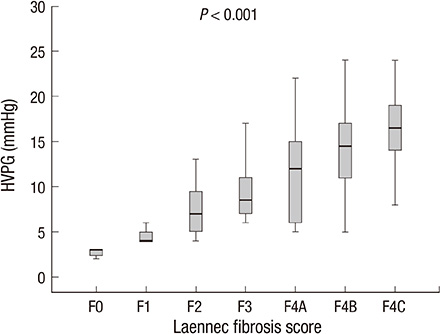J Korean Med Sci.
2014 Mar;29(3):392-399. 10.3346/jkms.2014.29.3.392.
Relationship between Tetrahydrobiopterin and Portal Hypertension in Patients with Chronic Liver Disease
- Affiliations
-
- 1Department of Internal Medicine, Wonju Severance Christian Hospital, Yonsei University Wonju College of Medicine, Wonju, Korea. baiksk@yonsei.ac.kr
- 2Department of Pathology, Wonju Severance Christian Hospital, Yonsei University Wonju College of Medicine, Wonju, Korea.
- 3School of Biological Sciences, Inje University College of Medicine, Gimhae, Korea.
- 4Department of Physiology and Biophysics, Inje University College of Medicine, Busan, Korea.
- 5Department of Nursing, Keimyung University College of Nursing, Daegu, Korea.
- KMID: 1734927
- DOI: http://doi.org/10.3346/jkms.2014.29.3.392
Abstract
- Tetrahydrobiopterin (BH4) is an essential cofactor in NO synthesis by endothelial nitric oxide synthase (eNOS) enzymes. It has been previously suggested that reduced intrahepatic BH4 results in a decrease in intrahepatic NO and contributes to increased hepatic vascular resistance and portal pressure in animal models of cirrhosis. The main aim of the present study was to evaluate the relationship between BH4 and portal hypertension (PHT). One hundred ninety-three consecutive patients with chronic liver disease were included in the study. Liver biopsy, measurement of BH4 and hepatic venous pressure gradient (HVPG) were performed. Hepatic fibrosis was classified using the Laennec fibrosis scoring system. BH4 levels were determined in homogenized liver tissues of patients using a high performance liquid chromatography (HPLC) system. Statistical analysis was performed to evaluate the relationship between BH4 and HVPG, grade of hepatic fibrosis, clinical stage of cirrhosis, Child-Pugh class. A positive relationship between HVPG and hepatic fibrosis grade, clinical stage of cirrhosis and Child-Pugh class was observed. However, the BH4 level showed no significant correlation with HVPG or clinical features of cirrhosis. BH4 concentration in liver tissue has little relation to the severity of portal hypertension in patients with chronic liver disease.
Keyword
MeSH Terms
-
Adult
Aged
Biopterin/*analogs & derivatives/analysis
*Chromatography, High Pressure Liquid
Chronic Disease
Elasticity Imaging Techniques
Female
Hepatic Veins/physiology
Humans
Hypertension, Portal/complications/*diagnosis/metabolism
Liver/pathology
Liver Cirrhosis/ultrasonography
Liver Diseases/complications/*diagnosis/metabolism
Male
Middle Aged
Nitric Oxide/metabolism
Portal Pressure
Regression Analysis
Severity of Illness Index
Biopterin
Nitric Oxide
Figure
Reference
-
1. Suk KT, Baik SK, Yoon JH, Cheong JY, Paik YH, Lee CH, Kim YS, Lee JW, Kim DJ, Cho SW, et al. Revision and update on clinical practice guideline for liver cirrhosis. Korean J Hepatol. 2012; 18:1–21.2. Kim JN, Sohn KM, Kim MY, Suk KT, Jeong SW, Jung HE, Lee SH, Kim SG, Jang JY, Kim YS, et al. Relationship between the hepatic venous pressure gradient and first variceal hemorrhage in patients with cirrhosis: a multicenter retrospective study in Korea. Clin Mol Hepatol. 2012; 18:391–396.3. Kim MY, Baik SK, Suk KT, Yea CJ, Lee IY, Kim JW, Cha SH, Kim YJ, Um SH, Han KH. Measurement of hepatic venous pressure gradient in liver cirrhosis: relationship with the status of cirrhosis, varices, and ascites in Korea. Korean J Hepatol. 2008; 14:150–158.4. Kaneda K, Ekataksin W, Sogawa M, Matsumura A, Cho A, Kawada N. Endothelin-1-induced vasoconstriction causes a significant increase in portal pressure of rat liver: localized constrictive effect on the distal segment of preterminal portal venules as revealed by light and electron microscopy and serial reconstruction. Hepatology. 1998; 27:735–747.5. Wiest R, Groszmann RJ. The paradox of nitric oxide in cirrhosis and portal hypertension: too much, not enough. Hepatology. 2002; 35:478–491.6. Kim MY, Baik SK. Pathophysiology of portal hypertension, what's new? Korean J Gastroenterol. 2010; 56:129–134.7. Kim MY, Baik SK, Lee SS. Hemodynamic alterations in cirrhosis and portal hypertension. Korean J Hepatol. 2010; 16:347–352.8. Gupta TK, Toruner M, Chung MK, Groszmann RJ. Endothelial dysfunction and decreased production of nitric oxide in the intrahepatic microcirculation of cirrhotic rats. Hepatology. 1998; 28:926–931.9. Van De Casteele M, Van Pelt JF, Nevens F, Fevery J, Reichen J. Low NO bioavailability in CCl4 cirrhotic rat livers might result from low NO synthesis combined with decreased superoxide dismutase activity allowing superoxide-mediated NO breakdown: a comparison of two portal hypertensive rat models with healthy controls. Comp Hepatol. 2003; 2:2.10. Graupera M, García-Pagán JC, Abraldes JG, Peralta C, Bragulat M, Corominola H, Bosch J, Rodés J. Cyclooxygenase-derived products modulate the increased intrahepatic resistance of cirrhotic rat livers. Hepatology. 2003; 37:172–181.11. Thöny B, Auerbach G, Blau N. Tetrahydrobiopterin biosynthesis, regeneration and functions. Biochem J. 2000; 347:1–16.12. Werner ER, Blau N, Thöny B. Tetrahydrobiopterin: biochemistry and pathophysiology. Biochem J. 2011; 438:397–414.13. Tejero J, Stuehr D. Tetrahydrobiopterin in nitric oxide synthase. IUBMB Life. 2013; 65:358–365.14. Matei V, Rodríguez-Vilarrupla A, Deulofeu R, Colomer D, Fernández M, Bosch J, Garcia-Pagán JC. The eNOS cofactor tetrahydrobiopterin improves endothelial dysfunction in livers of rats with CCl4 cirrhosis. Hepatology. 2006; 44:44–52.15. Matei V, Rodríguez-Vilarrulpla A, Deulofeu R, García-Calderó H, Fernández M, Bosch J, Garcia-Pagán JC. Three-day tetrahydrobiopterin therapy increases in vivo hepatic NOS activity and reduces portal pressure in CCl4 cirrhotic rats. J Hepatol. 2008; 49:192–197.16. Kim MY, Cho MY, Baik SK, Park HJ, Jeon HK, Im CK, Won CS, Kim JW, Kim HS, Kwon SO, et al. Histological subclassification of cirrhosis using the Laennec fibrosis scoring system correlates with clinical stage and grade of portal hypertension. J Hepatol. 2011; 55:1004–1009.17. Intraobserver and interobserver variations in liver biopsy interpretation in patients with chronic hepatitis C: the French METAVIR Cooperative Study Group. Hepatology. 1994; 20:15–20.18. Lee CK, Han JS, Won KJ, Jung SH, Park HJ, Lee HM, Kim J, Park YS, Kim HJ, Park PJ, et al. Diminished expression of dihydropteridine reductase is a potent biomarker for hypertensive vessels. Proteomics. 2009; 9:4851–4858.19. Bosch J, Mastai R, Kravetz D, Navasa M, Rodés J. Hemodynamic evaluation of the patient with portal hypertension. Semin Liver Dis. 1986; 6:309–317.20. Groszmann RJ, Wongcharatrawee S. The hepatic venous pressure gradient: anything worth doing should be done right. Hepatology. 2004; 39:280–282.21. Kim MY, Baik SK, Yea CJ, Lee IY, Kim HJ, Park KW, Kim HK, Suk KT, Kim JW, Kim HS, et al. Hepatic venous pressure gradient can predict the development of hepatocellular carcinoma and hyponatremia in decompensated alcoholic cirrhosis. Eur J Gastroenterol Hepatol. 2009; 21:1241–1246.22. Sandrin L, Tanter M, Gennisson JL, Catheline S, Fink M. Shear elasticity probe for soft tissues with 1-D transient elastography. IEEE Trans Ultrason Ferroelectr Freq Control. 2002; 49:436–446.23. Sandrin L, Fourquet B, Hasquenoph JM, Yon S, Fournier C, Mal F, Christidis C, Ziol M, Poulet B, Kazemi F, et al. Transient elastography: a new noninvasive method for assessment of hepatic fibrosis. Ultrasound Med Biol. 2003; 29:1705–1713.24. De Franchis R. Evolving consensus in portal hypertension: report of the Baveno IV consensus workshop on methodology of diagnosis and therapy in portal hypertension. J Hepatol. 2005; 43:167–176.25. D'Amico G, Garcia-Tsao G, Pagliaro L. Natural history and prognostic indicators of survival in cirrhosis: a systematic review of 118 studies. J Hepatol. 2006; 44:217–231.26. Kim MY, Baik SK. Hyperdynamic circulation in patients with liver cirrhosis and portal hypertension. Korean J Gastroenterol. 2009; 54:143–148.27. Groszmann RJ. Hyperdynamic circulation of liver disease 40 years later: pathophysiology and clinical consequences. Hepatology. 1994; 20:1359–1363.28. Alp NJ, Channon KM. Regulation of endothelial nitric oxide synthase by tetrahydrobiopterin in vascular disease. Arterioscler Thromb Vasc Biol. 2004; 24:413–420.29. Alp NJ, Mussa S, Khoo J, Cai S, Guzik T, Jefferson A, Goh N, Rockett KA, Channon KM. Tetrahydrobiopterin-dependent preservation of nitric oxide-mediated endothelial function in diabetes by targeted transgenic GTP-cyclohydrolase I overexpression. J Clin Invest. 2003; 112:725–735.30. Chidley C, Haruki H, Pedersen MG, Muller E, Johnsson K. A yeast-based screen reveals that sulfasalazine inhibits tetrahydrobiopterin biosynthesis. Nat Chem Biol. 2011; 7:375–383.31. Haruki H, Pedersen MG, Gorska KI, Pojer F, Johnsson K. Tetrahydrobiopterin biosynthesis as an off-target of sulfa drugs. Science. 2013; 340:987–991.32. Johns DG, Dorrance AM, Tramontini NL, Webb RC. Glucocorticoids inhibit tetrahydrobiopterin-dependent endothelial function. Exp Biol Med (Maywood). 2001; 226:27–31.33. Kaufman S. New tetrahydrobiopterin-dependent systems. Annu Rev Nutr. 1993; 13:261–286.34. Nichol CA, Smith GK, Duch DS. Biosynthesis and metabolism of tetrahydrobiopterin and molybdopterin. Annu Rev Biochem. 1985; 54:729–764.35. Aoki C, Nakano A, Tanaka S, Yanagi K, Ohta S, Jojima T, Kasai K, Takekawa H, Hirata K, Hattori Y. Fluvastatin upregulates endothelial nitric oxide synthase activity via enhancement of its phosphorylation and expression and via an increase in tetrahydrobiopterin in vascular endothelial cells. Int J Cardiol. 2012; 156:55–61.36. Förstermann U, Li H. Therapeutic effect of enhancing endothelial nitric oxide synthase (eNOS) expression and preventing eNOS uncoupling. Br J Pharmacol. 2011; 164:213–223.37. Heller R, Unbehaun A, Schellenberg B, Mayer B, Werner-Felmayer G, Werner ER. L-ascorbic acid potentiates endothelial nitric oxide synthesis via a chemical stabilization of tetrahydrobiopterin. J Biol Chem. 2001; 276:40–47.38. Tóth M, Kukor Z, Valent S. Chemical stabilization of tetrahydrobiopterin by L-ascorbic acid: contribution to placental endothelial nitric oxide synthase activity. Mol Hum Reprod. 2002; 8:271–280.39. Bosch J, Abraldes JG, Fernández M, García-Pagán JC. Hepatic endothelial dysfunction and abnormal angiogenesis: new targets in the treatment of portal hypertension. J Hepatol. 2010; 53:558–567.40. Fernandez M, Vizzutti F, Garcia-Pagan JC, Rodes J, Bosch J. Anti-VEGF receptor-2 monoclonal antibody prevents portal-systemic collateral vessel formation in portal hypertensive mice. Gastroenterology. 2004; 126:886–894.
- Full Text Links
- Actions
-
Cited
- CITED
-
- Close
- Share
- Similar articles
-
- Hepatic venous pressure gradient: clinical use in chronic liver disease
- Recent Advances in the Pathogenesis and Clinical Evaluation of Portal Hypertension in Chronic Liver Disease
- Congenital Absence of the Portal Vein Presenting as Pulmonary Hypertension
- Ultrasonography for Noninvasive Assessment of Portal Hypertension
- Idiopathic Portal Hypertension





